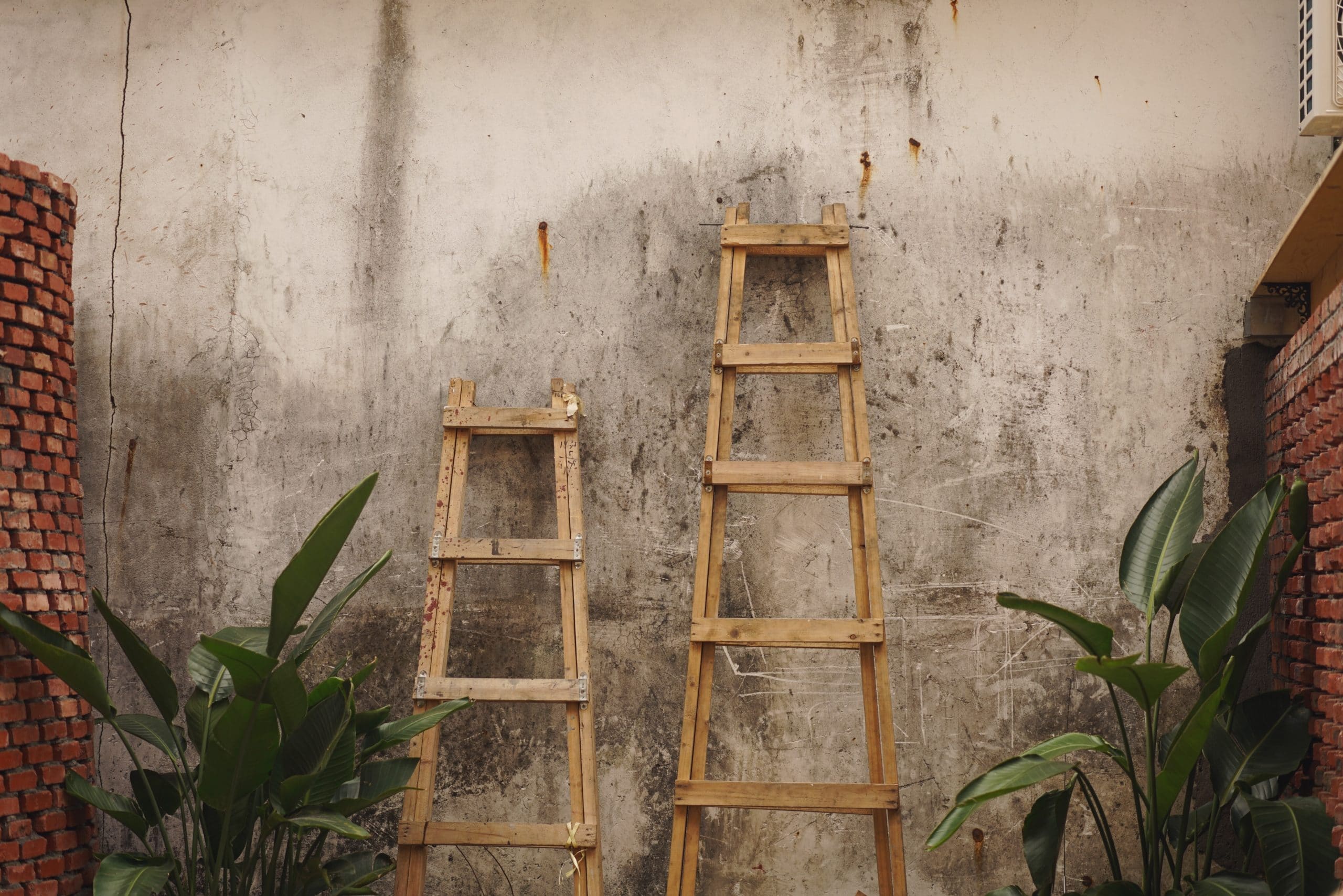
The end of the first Program Increment arrives within the Tribe that I accompany and the question of the animation of the retrospective arises.
Following an exchange with people with key roles in the organization, I undertook to propose a format allowing these 60 people to work together for 2 hours, in an agile way of course!
Here is my proposal in detail! 🙂
Note: For those who have read my previous articles titled “ 30 people, one hour: some retrospective formats“, know that the progression is not linear! 😛
Context
Before going into the details of my proposal, here are some elements of context:
- Topics have started to be listed by the Scrum Masters of the different teams during the weekly Scrum of Scrums
- Subjects that seem to require dedicated working time have been set aside
- Several format proposals were mentioned following inspiration from other contexts: Open Space, World Café, etc.
- Most of the time, a certain number of subjects were selected upstream in order to focus people on their treatment during the time of the retrospective.
After a few exchanges with a fellow coach, we agreed on the fact that it was important to address subjects representative of the field and the needs of the teams so that this event makes sense to everyone.
In addition to that, we thought that bringing out these subjects rather than imposing them would be more consistent with the Agile approach that we wanted to put in place. Now, it was also necessary not to turn this moment into a "crying office" as some people have experienced in the past.
As the saying goes:
You don't get a second chance to make a good first impression.
For a first retrospective of Tribu, there is therefore something at stake!
Unrolled
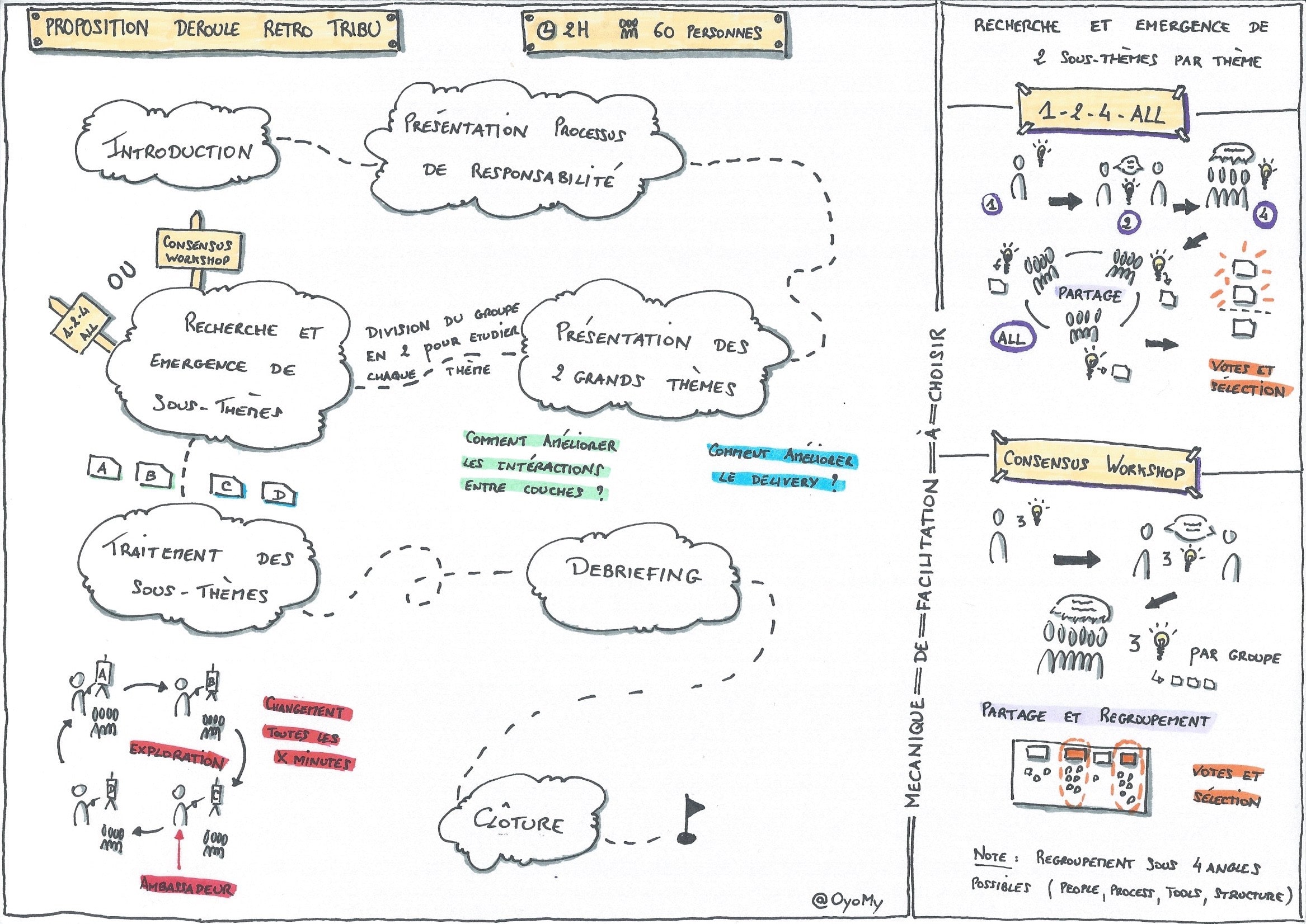
As shown in the Scribing above, the proposed format consists of 2 complementary parts: a common thread and a part with options. After all, this was only a proposal! 🙂
It turns out that it was the option with the “Consensus Workshop” type mechanic that was selected, so that is the one I will describe below.
Note: You will understand why I say "type" and not "Consensus Workshop" as such.
Let’s describe the common thread first:
- Introduction (5′)
We recall the intention of the retrospective and we explain what we are trying to achieve after the 2 hours.
We can potentially talk about animation steps but I haven't always found that to be useful on its own apart from the informative aspect. The idea is above all to accompany the participants well at each stage.
- Presentation of the Accountability Process (5′) :
At first, I thought to display this sentence:
We can easily complain about a situation, which we build and take advantage of.
The intention is above all to avoid this famous “office of tears” by highlighting the fact that we all have a responsibility in what happens to us. We're here to fix it!
We can potentially see how this phrase resonates with some people to hopefully set the tone for the event.
In a second time, I thought to display the Accountability process :
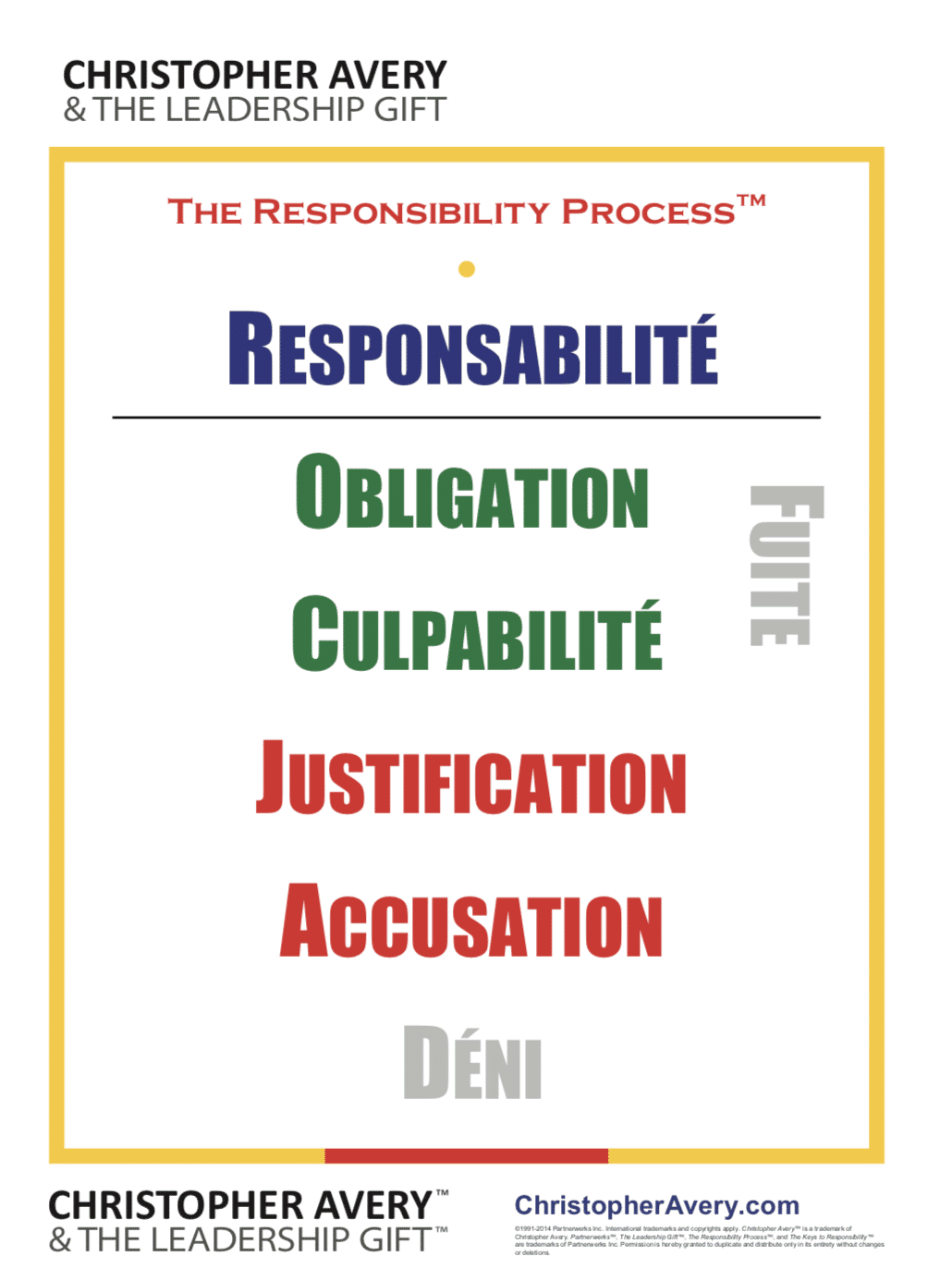
Without going into the details of the model itself, the message I wanted to get across is that when you are below the line – i.e. Accusation, Justification, Guilt, Obligation or the Leak – we talk about the problem more than we solve it.
It is really relevant to exchange only when we are in the mental state of Responsibility: that is to say, being fully aware of our ability to respond to the situation and assuming the consequences.
We then quickly move on to the next sequence.
Note: My underlying intention is to allow participants to have an additional reading grid during the exchanges that will take place thereafter. Potentially, they could also help each other stay in Responsibility.
- Presentation of the 2 main themes (5′)
As I said above, it seemed important to me to give as much of a hand as possible to the participants and therefore to bring out the subjects likely to bring the most value at this given moment.
However, with a group of 60 people and in the allotted time, it seemed complicated to me to attempt blind emergence.
Starting from the information I had from the field and basing myself on the list of subjects brought by the teams as I went along, I selected 2 major themes in which the emergence will take place. You could say that I am defining here the framework in which self-organization will be safe.
These 2 main themes are:
- How to improve interactions between layers (team and program)?
- How to improve Delivery?
We have here a vertical problem and a horizontal problem allowing, in my opinion, to cover all the possible subjects.
Participants are then asked to form 2 groups of 30 people, as representative as possible of the entire Tribe, and to select one of the 2 themes.
Note: a trick is to have 30 post-its of one color and 30 post-its of another color to see the distribution easily.
Finally, we define 2 spaces in the room to allow each group to work more serenely.
- Research and emergence of sub-themes (20′)
We enter the mechanic that I described as “Consensus Workshop type”.
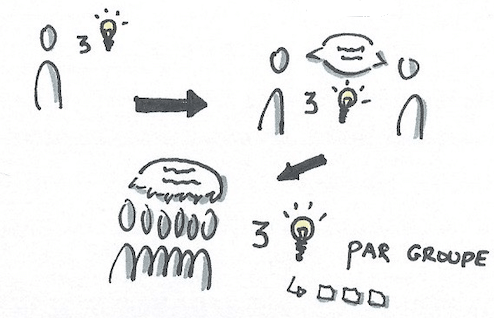
In each group, participants will be asked:
-
- (1′) To think individually about 3 ideas
- (2′) To think in pairs and keep only 3 ideas
- (5′) To think of 6 and keep only 3 ideas
Note: Having a group of 30 people, we therefore arrive at a total of 15 ideas.
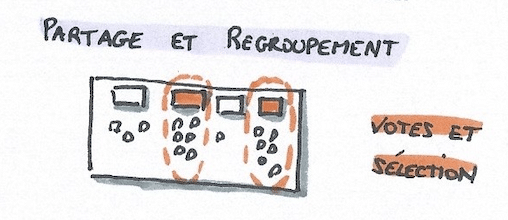
- (10′) We then share in a complete group on a common flat surface such as a wall or a sticky wall prepared beforehand with 4 main categories: People, Process, Tools, Structure.
Groups are invited to explain their ideas one by one and place them in the most appropriate category. If another group has a similar idea, they can also submit their idea to save time.
We will then select the 2 most extensive categories to study them in more depth in the following sequence.
Note: The idea of categories is only a way to quickly see the kind of problems currently encountered in teams. We could have used another model for the shot but this one is the one I particularly like at the moment 😛
- Treatment of subtopics (45′)
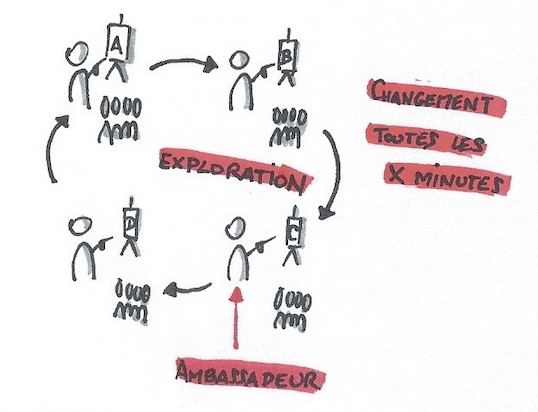
We arrive at this sequence with normally 4 sub-themes identified: 2 coming from the theme of improving interactions between layers and 2 coming from the theme of improving Delivery.
The group is again complete with 60 people and learns about the 4 sub-themes that it will have to deal with.
We will operate here in the form of a World Café:
-
- 4 Islands each corresponding to a sub-theme
- An ambassador whose mission will be to make restitution
- A paperboard (which we will have previously formatted for the restitution) and markers of course
Speaking of Paperboard, here is the format I propose:
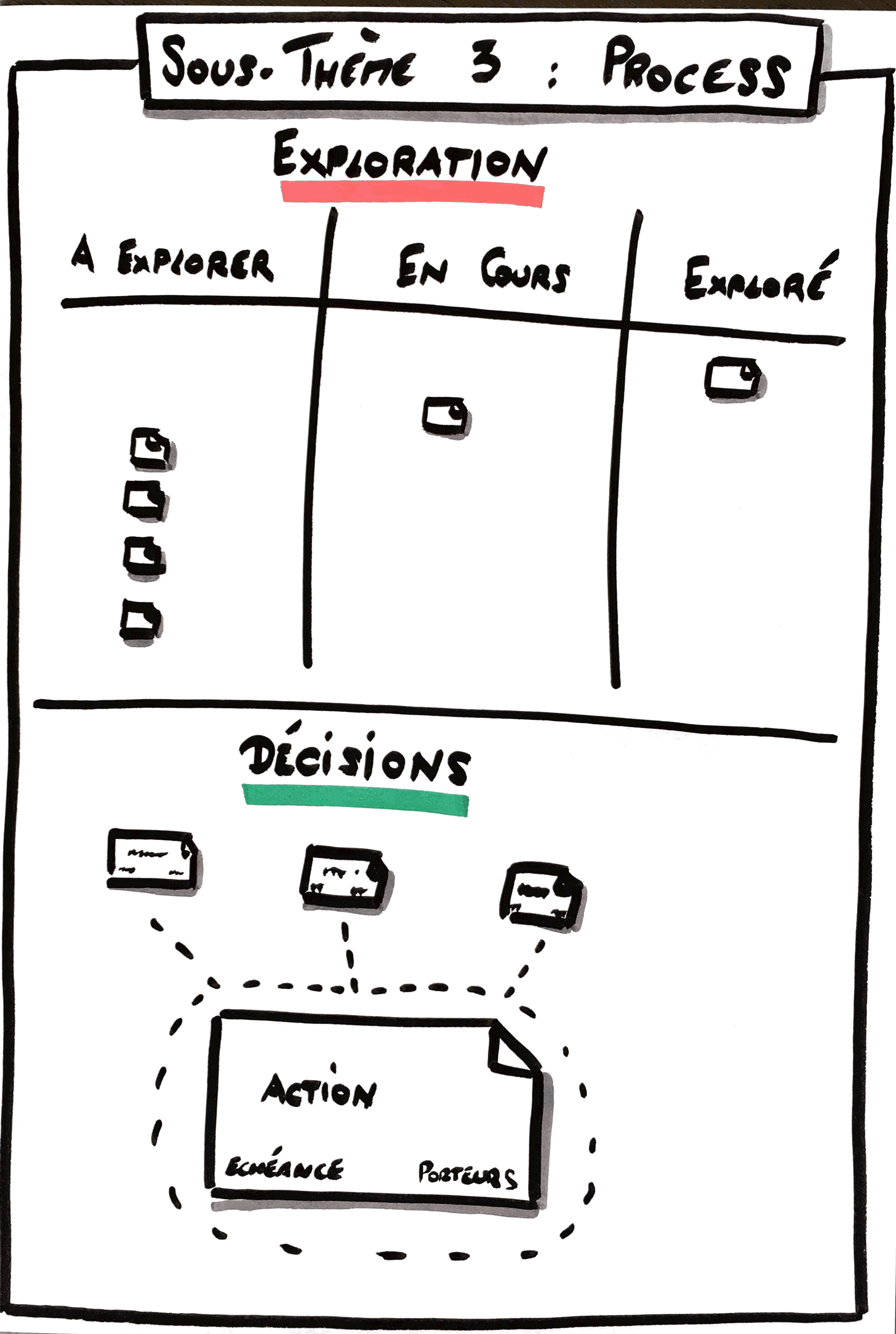
The main idea of this format is based on the following elements:
- Exploration : all the ideas presented under this theme are stored in the first column "To Explore". As its name suggests, we will explore one by one the ideas that have been proposed, even if it means adding / modifying / deleting some along the way. The intention is to animate this part in the same vein as in my article “ Meeting optimization through facilitation“.
- Decision : whenever possible, an action is defined and placed in this space. It will be characterized by a wording, one or more bearers and a maturity. These are the elements that will be reported to the whole group during the debriefing.
The participants are then distributed equitably among the islands and every 10 minutes, an audible signal will indicate that they have the possibility of changing islands and contributing to another subject if they so wish.
Note: Indeed, it seemed relevant to let people choose to move or not depending on the commitment they might have on a subject.
- Debriefing (20′)
The debriefing phase should be quite simple in the sense that the Flipcharts have a similar format, setting up the speech in a way.
Each ambassador is given 5 minutes to present the content of their subject as well as the actions and the holders defined.
- Fence (10′)
To close the session, we can do a ROTI, but to be honest, I'm not a fan of it (cf my article on the subject).
Since this is the first retrospective, I would rather ask how the participants experienced this session and how we could do better next time.
Let's not forget to thank everyone for the work done and leave with a smile! 🙂
Conclusion
This is what the proposal I made for this retrospective looks like. Having not yet had a league, I can't give you any feedback yet, but what is certain is that it will be challenging and will require quality facilitation to meet the objectives and the timing!
Hoping that it will nevertheless have been able to feed your curiosity, do not hesitate to tell me how you would have answered this challenge 🙂







2 Responses
Super Olivier, it makes you want to try… Thank you for this moment of reading, can’t wait to have the feedback from the feedback on the retro 😉
Thank you Olivier for this proposal, I would be happy to have your feedback when you have unrolled it,